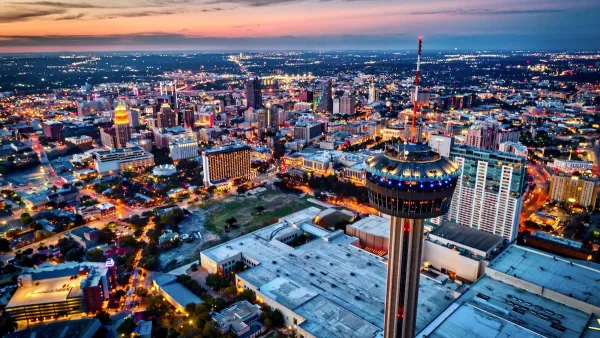Toronto is positioning itself to become a world model for sustainable waterfront development and has now completed the design phase of a 30 year effort. Urban planner Mary Vogel sets out to explore whether they are meeting their mark.
While its planning efforts to date have been extraordinary, Vogel notes that infrastructure from its past may handicap Toronto's exemplary sustainability goals -- unless the city can find the will to remove a rail yard, and perhaps a freeway.
The city has done a lot of things right: it looked carefully at European models, and engaged its residents in an in-depth effort to craft a Sustainability Framework. "Waterfront Toronto" has now completed precinct plans and block plans for two of its new waterfront development districts. Each again had a great deal of citizen involvement.
Vogel examines the West Don Lands plan, the first new neighborhood to get built. While praising its excellence in many other areas of urban design, she feels that it misses the mark by failing to emphasize in its streetscapes the kind of stormwater management that will help get Toronto off the list of the International Joint Commission's "areas of concern" for the Great Lakes.
Vogel commends Waterfront Toronto for inviting a Swedish Sustainability Review team to look at its plans and process and for publishing its report-with its compliments as well as criticisms-on the WT web site. According to the Swedish team, "The rail yard south of West Don Lands as well as the eight-lane-wide expressway is an extreme barrier between the city and the Port Lands area."
While Vogel covers the development aspect of what Toronto is planning in some depth, her article also stresses the fact that excellence in waterfront development is NOT just about development, but about restoring the health of the water body that creates your waterfront. This takes strong policies by various units of government as well as a land acquisition/restoration and an educational program. Toronto has all of these elements.
"The sustainability framework goes beyond requiring a LEED Gold rating for sustainable buildings in suggesting that buildings be designed to incorporate atriums, winter gardens, rooftop gardens, terraces, greenhouses and other elements that visually connect people with plants," she writes. "In its nature-oriented actions, Toronto seeks to improve the ecological health of the shoreline, including reintroduction of top predators. . . increased structural diversity across the waterfront, and protection and restoration of the habitat for all wildlife, including migratory birds."
After reporting on some of the hometown media skepticism, Vogel gives Waterfront Toronto CEO John Campbell the last word: "This represents an unprecedented opportunity for enlightened developers-nearly 2,000 acres [800 ha] in the heart of Canada's largest city with opportunities for the next 25 to 30 years."
[The full article is available as a PDF courtesy of the Urban Land Magazine]
Thanks to Michael Mehaffy
FULL STORY: Greening Waterfront Development [PDF]

Planetizen Federal Action Tracker
A weekly monitor of how Trump’s orders and actions are impacting planners and planning in America.

Chicago’s Ghost Rails
Just beneath the surface of the modern city lie the remnants of its expansive early 20th-century streetcar system.

San Antonio and Austin are Fusing Into one Massive Megaregion
The region spanning the two central Texas cities is growing fast, posing challenges for local infrastructure and water supplies.

Since Zion's Shuttles Went Electric “The Smog is Gone”
Visitors to Zion National Park can enjoy the canyon via the nation’s first fully electric park shuttle system.

Trump Distributing DOT Safety Funds at 1/10 Rate of Biden
Funds for Safe Streets and other transportation safety and equity programs are being held up by administrative reviews and conflicts with the Trump administration’s priorities.

German Cities Subsidize Taxis for Women Amid Wave of Violence
Free or low-cost taxi rides can help women navigate cities more safely, but critics say the programs don't address the root causes of violence against women.
Urban Design for Planners 1: Software Tools
This six-course series explores essential urban design concepts using open source software and equips planners with the tools they need to participate fully in the urban design process.
Planning for Universal Design
Learn the tools for implementing Universal Design in planning regulations.
planning NEXT
Appalachian Highlands Housing Partners
Mpact (founded as Rail~Volution)
City of Camden Redevelopment Agency
City of Astoria
City of Portland
City of Laramie


























